-
 Top Diwali Gifts for 2020 to Give to Family, Friends and Associates
Top Diwali Gifts for 2020 to Give to Family, Friends and Associates
-
 Diwali Snacks You Can Make in Your Kitchen, which Are As Healthy As They Are Delicious! (2021)
Diwali Snacks You Can Make in Your Kitchen, which Are As Healthy As They Are Delicious! (2021)
-
 Have You Ever Thought of Creating Your Decorations and Adding Your Personality to Your Home(2021)? DIY Diwali Decoration Ideas and Crafts that You can Indulge in and Create Interesting Decor Items for Your Home This Diwali.
Have You Ever Thought of Creating Your Decorations and Adding Your Personality to Your Home(2021)? DIY Diwali Decoration Ideas and Crafts that You can Indulge in and Create Interesting Decor Items for Your Home This Diwali.
Making Rangolis on Diwali
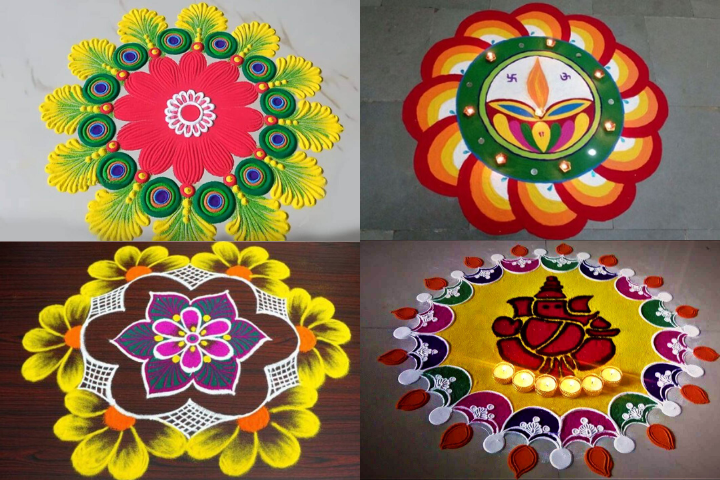
Diwali is an auspicious occasion to celebrate with friends and family. As we welcome goddess Lakshmi to our household, we want it to be decorated with lights, colours, flowers and greet her with tasty sweets and food. Rangoli fulfil the colour element of the festival and it is considered to be sacred to have a Rangoli in front of the door as a welcome gesture for the goddess as well as the guests.
It is believed that Rangolis have spiritual significance apart from the fact that they attract positive energy. If you see, most of the Rangolis have symmetry in design for a proper balance. The round ones are the simplest form of symmetrical Rangolis. In case you want to attract sharp energy, it is said that Rangolis with sharp edges should be drawn.
Top 3 Things to Use to Make Rangolis on Diwali
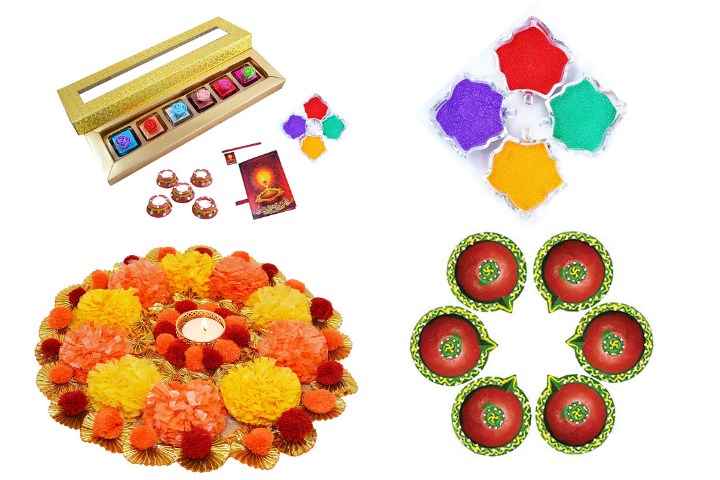
The Rangoli in every household has different flavours. Though it is a colourful art form, it is believed to bring luck to the household. It’s generally a combination of the colours, the light and the fragrances of flowers. So, these are the three elements of Rangoli, Diyas, Powdered Colours and Flowers.
#1 Diyas
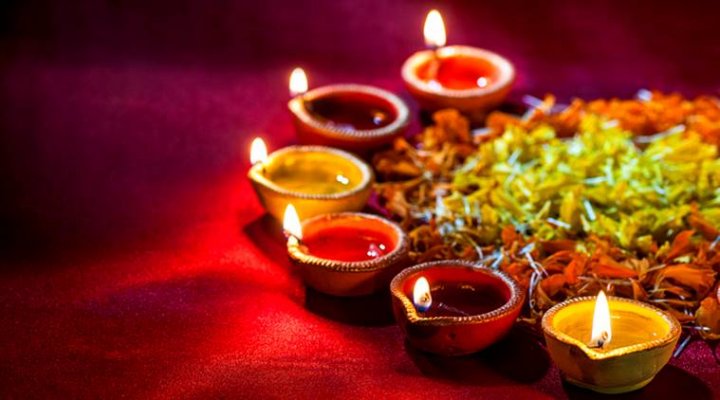
Diyas are typically made of clay. They are dried and painted or crafted to make different designs. As Diwali is celebrated on a new moon day, Diyas bring to light as well as a good vibe. Most of the Rangolis are incomplete without a Diya or many Diyas, depending on the design. As Diwali is celebrated after the sundown, it bears some importance. You can purchase the clay Diyas available in the market at a quite cheap rate. You can also use metal diyas and use Ghee or Mustard oil as the fuel for it. It is also quite easy to make Diyas at home.
#2 Powdered Colours

Special powdered colours are used to make Rangoli. They are not colours used for playing Holi and their granules are bigger than the dust colours. Many shades are available in the powdered colours and you can choose any combination according to your design. The use of white, yellow, orange, green, pink, blue and red is quite popular. Even if you don’t have access to the special colours for Rangoli, you can make it at home. All you need is sieve sand and Gulal or the holi colour. You need to mix these in proper proportion to create the required colour. The white is the trickiest colour to make. You can use rice flour for the same.
#3 Flowers
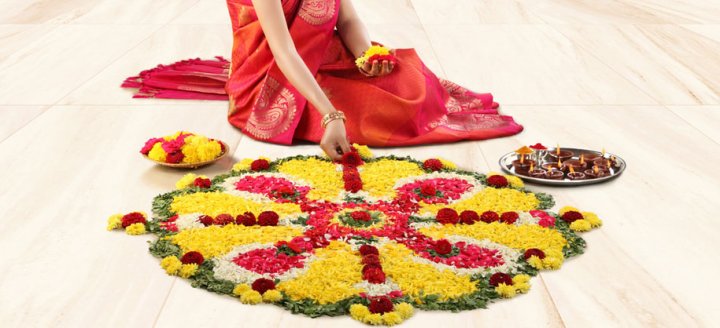
While Rangoli with colours is the most popular type, there is also some Rangoli made with flower petals. There are a combination of Rangolis too, made with flowers and Diyas, and they look amazing. The flowers bring freshness to the whole design and different colours of flowers are used to create a vivid appeal to the Rangoli. Marigold is the most common flower used, though you will also find jasmine and rose petals in several Rangolis.
Top 5 Rangoli Designs to Make on Diwali
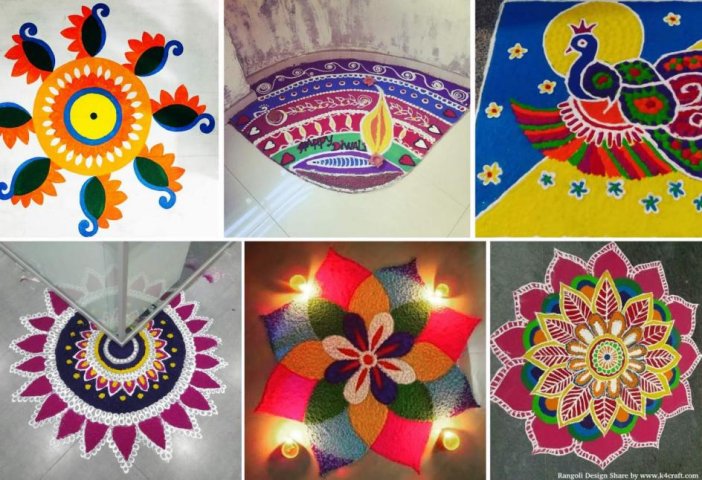
People prefer to make a different kind of Rangolis on the floor each bearing specific importance. There are some designs which have spiritual significance. Sometimes, it is just the beauty of the design that makes it so attractive to look at. Here are the top 5 designs of Rangolis made on Diwali. You will find one or the other at every household.
#1 Lakshmi Feet
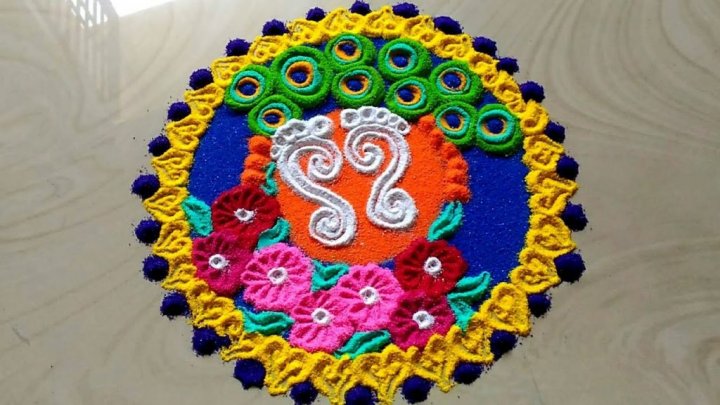
It is a common tradition to make Lakshmi feet in the Rangoli design. Lakshmi is the goddess of wealth and she is worshipped on a special day with a lot of love. People welcome her to the house and want her to stay so that the family never faces any financial distress. That is why the feet are drawn towards the house which indicates that Devi Lakshmi is coming in the home to bless the devotees with wealth and fortune. In most of the cases, white colour is used while drawing the Lakshmi's feet.
#2 Flowers
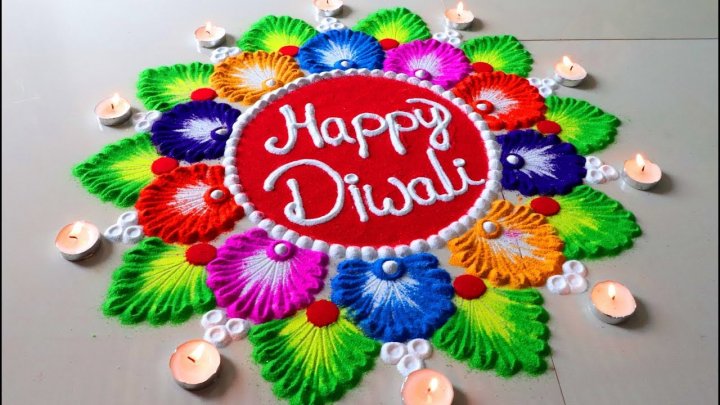
Many people prefer making flowers in their Rangoli. It is an easy design to create and you can make it as colourful as you want. You can make it as big as you want and as small as you like. There are so many options when it comes to flower design. You can make a cluster of flowers and make it look like a bouquet or a bush of flowers. Make sure to decorate with Diyas to complete the look. You can use more than one Diyas in a flower design as it perfectly suits it. The flower Rangoli can be made with actual flower petals or Rangoli powders. The flower Rangoli made with flower petals look wonderful.
#3 Mandala
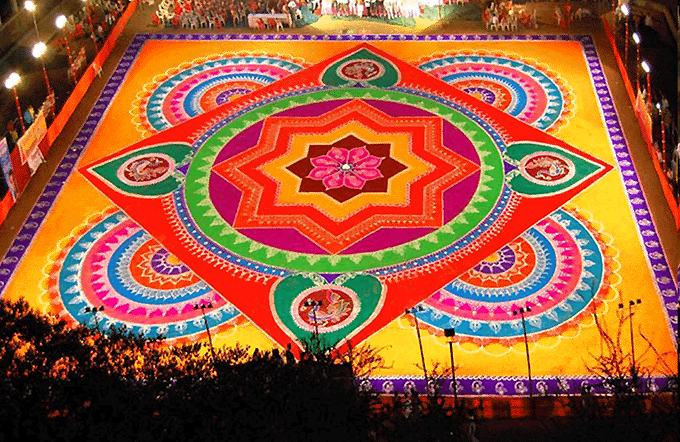
The Sanskrit translation of mandala is a circle. So, the Rangolis drawn in circular shape with the complex design is called a mandala. A circle is known to draw positive energies towards it, and on Diwali, you want nothing more than positive energy for your sweet household. It is one of the most common forms of Rangoli found in an Indian household and they are generally made by experts. The designs are beautiful but intricate and require a lot of patience. You can always draw a simple mandala if you are just starting with it or you can choose to make it beautiful with colourful petals and proper use of Diyas.
#4 Ganesh
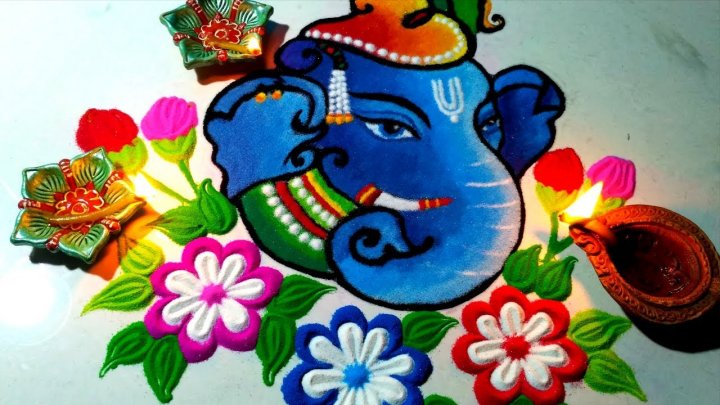
Any auspicious occasion in a Hindu Indian household is incomplete without the presence of Lord Ganesh. While we worship Lakshmi during Diwali, we also worship Ganesh who is her husband, according to mythology. There are some beautiful Rangoli designs of Ganesh available on the web which you can easily make, with some amount of precision. You will notice that multiple shapes are drawn in an order to create the whole body of Ganesh. The Ganesh Rangoli looks grand and is considered to be quite auspicious too.
#5 Abstract

While the specific designs are popular in Rangoli, people are equally interested to put an abstract figure in the Rangoli design. Rangoli design has become an art form and there are even competitions organized to see, who makes the best looking Rangoli. The abstract designs are not just anything you draw upon the floor, they are generally geometric pattern with sharp edges. There are some really beautiful designs of Rangolis available online that you can check out. Some of them are quite complex but the outcome looks amazing.
Top 5 Rangoli Designs with Diyas

#1 Shubh-Labh

Shubh-labh in general means an overall uplifting of your being. The words are often accompanied by the Swastika which is a symbol of Lord Ganesh. This means new beginning with a lot of luck and you may find it at the entry point of any office, workplace and even homes. A Rangoli of Shubh-Labh bears the same significance. You can make this simple design and then decorate it with diyas. This design is, anyway, almost always accompanied by at least one lighted Diya as it is a reverence to goddess Lakshmi. You can even opt to place small tealight style diyas/candles around it in different colours.
#2 Diya

Rangoli of Diya is also quite popular as a design for Diwali. Diwali is the festival of good concurring over bad and light concurring the dark. Diya bodily symbolizes the concept and putting a Diya Rangoli to the entrance of your home is the best thing you can do. Several colours are used in making the design. You can keep the look as close to the real look of the Diya in its earthy form or you can make it as colourful as you want. While some people prefer making a single Diya, some make a cluster of them and create a pattern that can look beautiful. You can place lighted diyas around it to make it more beautiful.
#3 Peacock
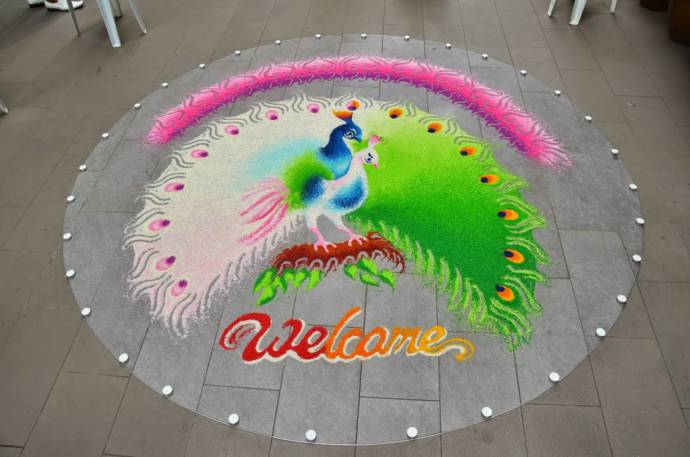
Peacock being the spirit animal symbolizes beauty, confidence and protection. Peacock is the most colourful Rangoli that you can ever see in a household and people who believe in the spiritual power of Peacock try to incorporate it in the Rangoli. Not only it is the most beautiful design but it is also quite difficult to make. You can choose any pose of the peacock while drawing it with your Rangoli colours but a dancing peacock in its full bloom is the best and most beautiful to look at.
There are some simple peacock designs as well which can be made by someone who is trying it for the first time. However, in most cases, you need to use colours and not flower petals for prominent colours of the feathers to come out. Once you have made the design, use diyas to add a glow to it. Some of the best ways in which you can add diyas are by placing it along the edges of the feathers of the bird or you can even envelope the peacock in a circular design and place diyas all around it.
#4 Circular Design
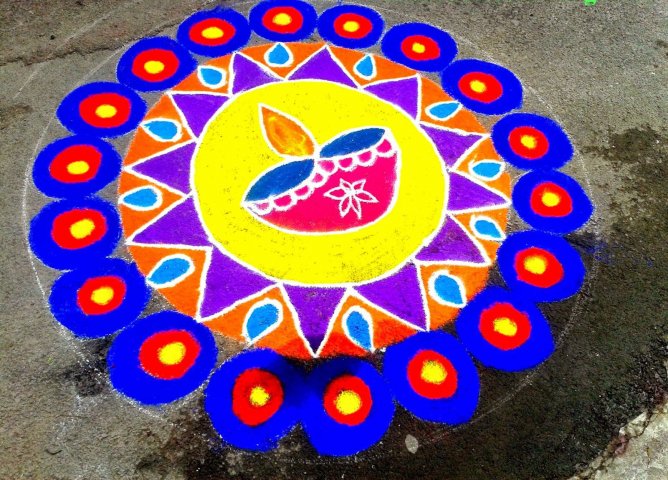
This is a very common yet striking design that people create with diyas. Start by placing a big diya, often colourful and decorated, in the centre, then place slightly smaller diyas around it, then even smaller ones around that. Go on doing that till you create a large circular design. You can use rangoli colours to make designs in between the gaps in diyas.
#5 Geometric
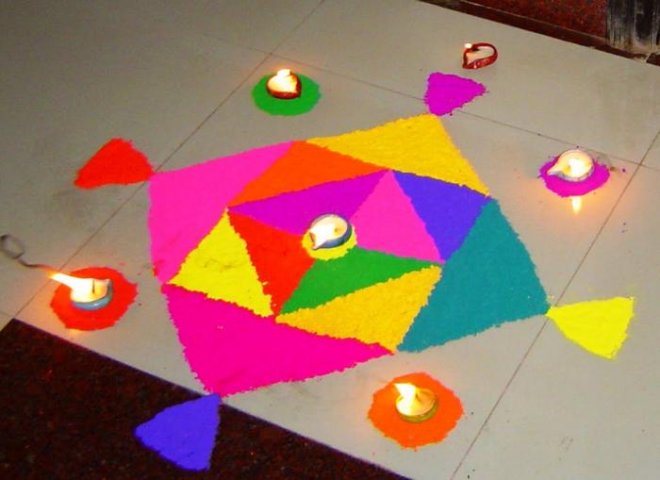
Geometrical Rangolis are almost like the abstract ones where you draw certain shapes but this time they are geometric shapes. For the geometric Rangolis, you have the artistic freedom to draw the shape that you want and make it as colourful as you like it. You can also incorporate flowers and Diyas in the Geometry shape to make it look even more attractive. Place diyas in the centre of the geometric rangoli design.
Top 3 Ways to Use Diyas in Rangoli Designs

People like to draw their Rangolis in many different ways. It is their choice of how they want to place the Diyas, where they want to draw it and how big they want it to be. Commonly, the Rangolis are drawn at the entrance of the house and protected so that nobody messes it up. There are practices and rituals at some houses regarding the placement of Diyas. These are according to their beliefs. Here are some of the common ways to use Diyas in Rangoli designs.
#1 Place Diyas in Centre of Designs
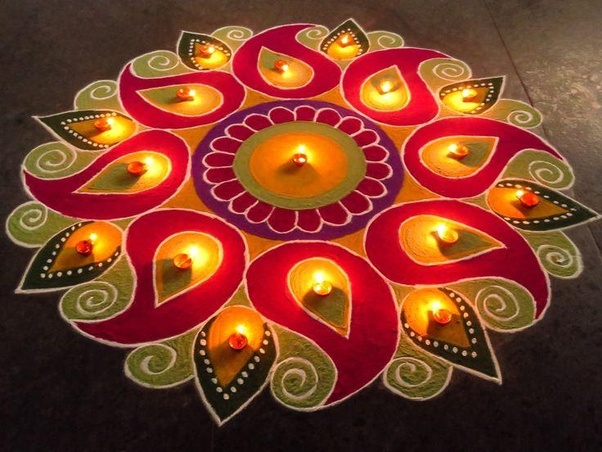
If you have seen Rangolis in a picture as well, you will see that the Diya is placed in the centre. Most of the cases these Rangolis are round in shape or have a symmetrical form. Many people put Diya in the centre when they draw a square Rangoli or a Swastika. It is believed to attract centralized positive energy and light up the whole Rangoli, and make it look beautiful even in low light. Instead of one Diya, 4 or 5 Diyas can also be placed at the centre for design purposes.
#2 Place Diyas Around the Design
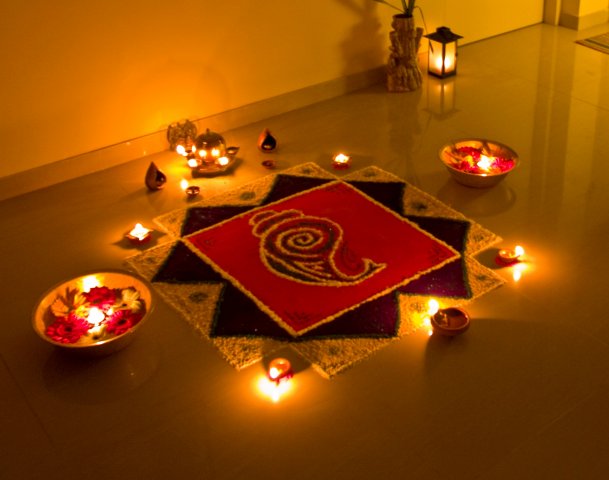
There are certain Rangolis where the Diyas are placed around the design. It seems like the edges of the Rangoli is sealed by the Diya and nothing dark can enter the space. It is a common practice in many households and it looks quite amazing too. There are some corner-based Rangolis and geometric shapes, where there is no place to put a diya in the centre. In those cases, too, Diyas are placed around the design.
#3 Make Small Rangoli Designs around Several Diyas
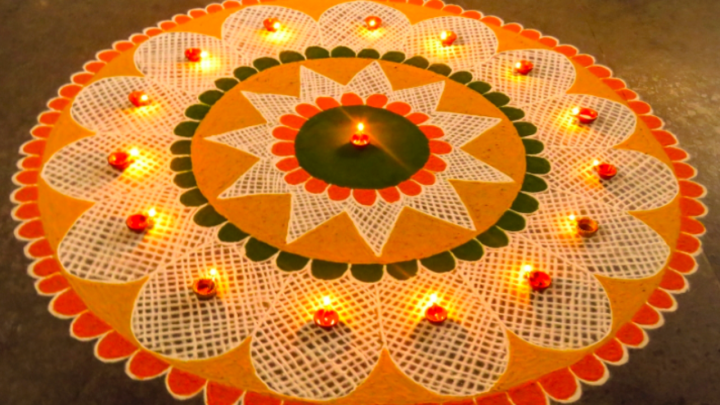
This is a very unique kind of Rangoli pattern where Diyas is the centre of several designs that consists of the whole design of the Rangoli. Here small Rangoli designs are drawn around the Diyas, so that, each Diya has its design. These designs can be quite pretty and can be big as well. However, you can place with the space allocation as each design has its significance. The Rangoli looks vivid and colourful too. If you want to make such a Rangoli design this year for Diwali, you can check out online for some great design ideas.
-
 Simple and Easy-To-Create Pongal Kolam Designs To Decorate Your Home Traditionally
Simple and Easy-To-Create Pongal Kolam Designs To Decorate Your Home Traditionally
-
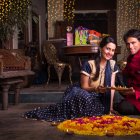 This Diwali, Prepare to Welcome Goddess Lakshmi with a Mix of Traditional and Contemporary Décor: Unique Diwali Decoration Ideas for Your Home to Make It Look Spectacular Like Never Before! (2020)
This Diwali, Prepare to Welcome Goddess Lakshmi with a Mix of Traditional and Contemporary Décor: Unique Diwali Decoration Ideas for Your Home to Make It Look Spectacular Like Never Before! (2020)
-
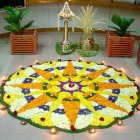 Creating Pookalams is One of the the Most Important Rituals of Onam: Make it Special with these Beautiful Onam Pookalam Designs (2020)!
Creating Pookalams is One of the the Most Important Rituals of Onam: Make it Special with these Beautiful Onam Pookalam Designs (2020)!
-
 10 Exquisite Pongal Rangoli Designs to Celebrate the Harvest Festival With and Why You Should Practice This Ancient Art (2020)
10 Exquisite Pongal Rangoli Designs to Celebrate the Harvest Festival With and Why You Should Practice This Ancient Art (2020)
-
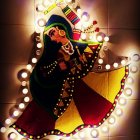 10 Divine Rangoli Designs for Navratri: Beautiful Rangolis To Welcome the Goddess and Also Good Luck to your Home! (Updated 2020)
10 Divine Rangoli Designs for Navratri: Beautiful Rangolis To Welcome the Goddess and Also Good Luck to your Home! (Updated 2020)
This Year, Don’t Settle Anything for Ordinary!
Don’t these Rangoli designs for Diwali look amazing? Make your festival even more special by recreating these fascinating patterns in your home. Do play with the colour palates and experiment with various shading techniques to create impressive effects. If you have come up with something more interesting, do let us know! Who knows, your work might get featured the next year?

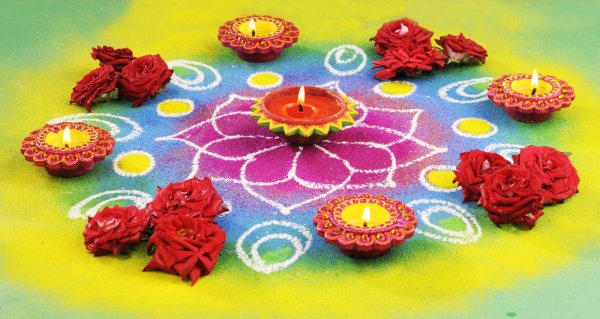
 Highlight the Best Facets of Your Incomparable Beauty: Discover the Best Face Highlighter Currently Available in India and Everything You Need to Know About Using Face Highlighters for Maximum Effect (2023)
Highlight the Best Facets of Your Incomparable Beauty: Discover the Best Face Highlighter Currently Available in India and Everything You Need to Know About Using Face Highlighters for Maximum Effect (2023)
 Forget the Blemishes and Get that Picture Perfect Flawless Radiance on Your Face: Check out the Best Foundations for Oily Skin Currently Available in India and Everything You Need to Know About Makeup Foundations (2023)
Forget the Blemishes and Get that Picture Perfect Flawless Radiance on Your Face: Check out the Best Foundations for Oily Skin Currently Available in India and Everything You Need to Know About Makeup Foundations (2023)
 Make Your Presence Felt Wherever You Go: Discover the Best Perfumes Under 2000 for Both Men and Women to Announce Your Arrival and Make Any Occasion Memorable (2023)
Make Your Presence Felt Wherever You Go: Discover the Best Perfumes Under 2000 for Both Men and Women to Announce Your Arrival and Make Any Occasion Memorable (2023)
 Protect Your Oily Skin from the Harmful Rays of the Sun: Discover the Best Gel Based Sunscreens for Oily Skin and Everything You Need to Know Before Buying One (2023)
Protect Your Oily Skin from the Harmful Rays of the Sun: Discover the Best Gel Based Sunscreens for Oily Skin and Everything You Need to Know Before Buying One (2023)
 Minor Blemishes and Wrinkles Affecting Your Confidence? Check out the Best BB Creams to Conceal Your Worries and Nourish Your Skin to Restore the Healthy, Radiant and Glowing Complexion Back Again (2023)
Minor Blemishes and Wrinkles Affecting Your Confidence? Check out the Best BB Creams to Conceal Your Worries and Nourish Your Skin to Restore the Healthy, Radiant and Glowing Complexion Back Again (2023)
